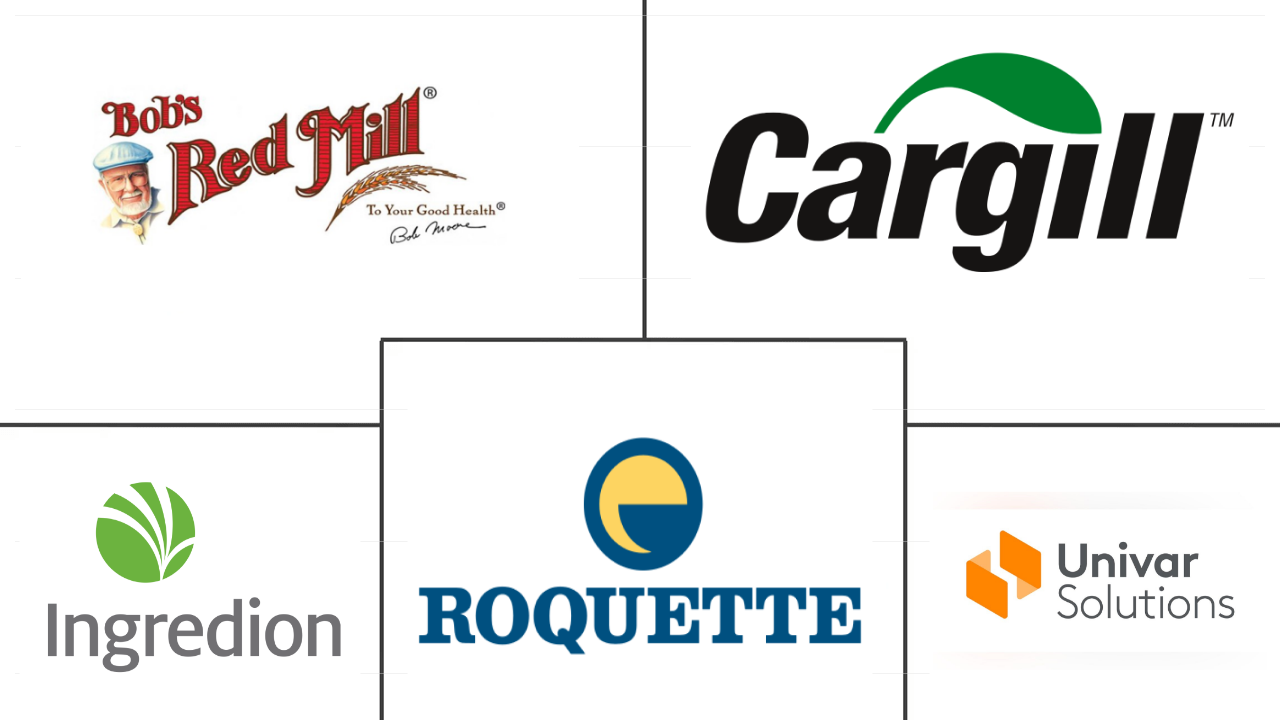Market Size of north america textured vegetable protein Industry
| Icons | Lable | Value |
|---|---|---|
|
|
Study Period | 2017 - 2029 |
|
|
Market Size (2024) | USD 1.61 Billion |
|
|
Market Size (2029) | USD 2.55 Billion |
|
|
Largest Share by Distribution Channel | On-Trade |
|
|
CAGR (2024 - 2029) | 9.63 % |
|
|
Largest Share by Country | United States |
|
|
Market Concentration | Low |
Major Players |
||

|
||
|
*Disclaimer: Major Players sorted in no particular order |
North America Textured Vegetable Protein Market Analysis
The North America Textured Vegetable Protein Market size is estimated at 1.61 billion USD in 2024, and is expected to reach 2.55 billion USD by 2029, growing at a CAGR of 9.63% during the forecast period (2024-2029).
1.61 Billion
Market Size in 2024 (USD)
2.55 Billion
Market Size in 2029 (USD)
5.36 %
CAGR (2017-2023)
9.63 %
CAGR (2024-2029)
Largest Segment by Country
79.48 %
value share, United States, 2023
Rising awareness of the benefits of textured vegetable protein (TVP) and the increasing demand for patties and TVP sausages are the driving factors in the US market.
Largest Segment by Distribution Channel
62.99 %
value share, On-Trade, 2023
A separate section of meat substitute products on menus in the food service sector and the continuous launch of new TVP products boost the market growth.
Fastest-growing Segment by Country
9.71 %
Projected CAGR, United States, 2024-2029
The market is being driven by local consumers switching to TVP due to environmental and animal welfare concerns, leading to growth in the vegan population.
Fastest-growing Segment by Distribution Channel
10.12 %
Projected CAGR, On-Trade, 2024-2029
The region's growing vegan population has led numerous foodservice outlets to add TVP items to their menus. This also promoted the launch of vegan restaurants in the region.
Leading Market Player
3.67 %
market share, Univar Solutions Inc., 2022

The company is a pioneer in TVP, and it has multiple brand offerings of the product. It also offers the product in different colors and sizes to cater to various customer demands.
Growing number of flexitarians and quick adaption by distribution channels are boosting the market
- In 2022, the on-trade segment was the major distribution channel in terms of value, registering a growth of 31.11% by value from 2017 to 2022. The rise of health-conscious millennials and boomers has increased demand for food items like textured vegetable protein across foodservice channels, which, in turn, depicts the health and wellness concerns of consumers. With the growing popularity of plant-based meat, major quick-service operators in the region, such as KFC, Burger King, Starbucks, etc., have partnered with plant meat manufacturers to include these items in their menus.
- The supermarkets/hypermarkets segment is considered the dominant channel for the sale of meat substitutes owing to its huge retail space catering to a wide variety of preferences, including textured vegetable protein. Dedicated sections for plant-based meat and other substitute products, along with attractive offers, are boosting sales through the channel. The online channel is the fastest-growing among the off-trade distribution channels segment, and it is projected to register a CAGR of 15.31% during the forecast period (2023-2029). To fulfill consumer demand and make it easier to acquire plant-based goods online, players in the sector are developing efficient e-commerce infrastructure at an exponential pace.
- One of the major reasons behind the increasing sales is the growing adoption of flexitarian diets. As of 2021, 47% of the population in the United States, including more than half (54%) of individuals aged 24 to 39, were flexitarians. This resulted in their preferences shifting toward plant proteins, such as textured vegetable protein products, hence boosting the market through off-trade and on-trade channels.
Huge investments in the plant-based foods industry driving market growth
- The demand for alternative meat products, like textured vegetable proteins, tofu, and other plant-based products, increased by 3% in value over 2017-2020. However, from 2020 to 2022, there was a 7.5% rise in the sales of plant-based products like textured vegetable proteins, mainly due to a decrease in animal-based food, innovations that claim it tastes like chicken but is 100% vegetarian, certifications, an increase in health consciousness over price consciousness, and marketing by multinational companies encouraging consumers to adopt new varieties of food.
- In North America, the United States is expected to account for the highest consumption of textured vegetable proteins. The United States is projected to register a CAGR of 9.37% by value during the forecast period (2023-2029). TVP options in retail and foodservice channels are growing. Plant-based foods such as TVP are now found in 48% of restaurants across the United States. The menu penetration of TVP-based burgers and sausages grew by around 20% in 2021. Plant-based meats have the strongest presence at fast-casual outlets, but mid-scale and casual dining channels are not far behind.
- Canada occupies the second position in the market for textured vegetable proteins. The government’s add-on support to plant-based products, like textured vegetable proteins, coupled with multiple new products flooding the market with advanced nutrition that can minimize the carbon footprint and greenhouse emissions, is attracting consumers in the Canadian market. The Government of Canada recently invested USD 150 million in the plant-based protein market for public safety and emergency. Additionally, the funds went toward promoting the research of plant-based meat such as pulses like chickpeas, peas, lentils, and beans.
North America Textured Vegetable Protein Industry Segmentation
Off-Trade, On-Trade are covered as segments by Distribution Channel. Canada, Mexico, United States are covered as segments by Country.
- In 2022, the on-trade segment was the major distribution channel in terms of value, registering a growth of 31.11% by value from 2017 to 2022. The rise of health-conscious millennials and boomers has increased demand for food items like textured vegetable protein across foodservice channels, which, in turn, depicts the health and wellness concerns of consumers. With the growing popularity of plant-based meat, major quick-service operators in the region, such as KFC, Burger King, Starbucks, etc., have partnered with plant meat manufacturers to include these items in their menus.
- The supermarkets/hypermarkets segment is considered the dominant channel for the sale of meat substitutes owing to its huge retail space catering to a wide variety of preferences, including textured vegetable protein. Dedicated sections for plant-based meat and other substitute products, along with attractive offers, are boosting sales through the channel. The online channel is the fastest-growing among the off-trade distribution channels segment, and it is projected to register a CAGR of 15.31% during the forecast period (2023-2029). To fulfill consumer demand and make it easier to acquire plant-based goods online, players in the sector are developing efficient e-commerce infrastructure at an exponential pace.
- One of the major reasons behind the increasing sales is the growing adoption of flexitarian diets. As of 2021, 47% of the population in the United States, including more than half (54%) of individuals aged 24 to 39, were flexitarians. This resulted in their preferences shifting toward plant proteins, such as textured vegetable protein products, hence boosting the market through off-trade and on-trade channels.
| Distribution Channel | ||||||
| ||||||
| On-Trade |
| Country | |
| Canada | |
| Mexico | |
| United States | |
| Rest of North America |
North America Textured Vegetable Protein Market Size Summary
The North America Textured Vegetable Protein (TVP) market is experiencing significant growth, driven by the increasing demand for plant-based meat alternatives among health-conscious consumers. The rise of flexitarian diets, particularly among millennials and boomers, has led to a shift in consumer preferences towards plant proteins, boosting the market's expansion. The market is characterized by a diverse range of distribution channels, with supermarkets and hypermarkets leading in sales due to their extensive retail space and attractive offers. The online channel is emerging as the fastest-growing segment, as companies invest in robust e-commerce infrastructure to meet the rising demand for plant-based products. Major quick-service operators in the region are also partnering with plant meat manufacturers to incorporate these products into their menus, further driving market growth.
In the United States, the demand for TVP is particularly strong, with the country expected to lead in consumption during the forecast period. The market in Canada is also growing, supported by government initiatives and investments in plant-based products. Despite rising prices due to factors like soybean market fluctuations and increased demand, the market remains competitive with key players such as Bob’s Red Mill Natural Foods, Cargill Inc., and Ingredion Inc. The market is fragmented, with the top companies holding a small share, indicating opportunities for new entrants. Strategic partnerships and alliances, such as those between Univar Solutions and ICL’s Rovitaris, and Bunge Limited and Nutrien Ag Solutions, are helping to expand plant-based protein options and support sustainable farming practices, respectively.
North America Textured Vegetable Protein Market Size - Table of Contents
-
1. MARKET SEGMENTATION (includes market size in Value in USD, Forecasts up to 2029 and analysis of growth prospects)
-
1.1 Distribution Channel
-
1.1.1 Off-Trade
-
1.1.1.1 Convenience Stores
-
1.1.1.2 Online Channel
-
1.1.1.3 Supermarkets and Hypermarkets
-
1.1.1.4 Others
-
-
1.1.2 On-Trade
-
-
1.2 Country
-
1.2.1 Canada
-
1.2.2 Mexico
-
1.2.3 United States
-
1.2.4 Rest of North America
-
-
North America Textured Vegetable Protein Market Size FAQs
How big is the North America Textured Vegetable Protein Market?
The North America Textured Vegetable Protein Market size is expected to reach USD 1.61 billion in 2024 and grow at a CAGR of 9.63% to reach USD 2.55 billion by 2029.
What is the current North America Textured Vegetable Protein Market size?
In 2024, the North America Textured Vegetable Protein Market size is expected to reach USD 1.61 billion.

